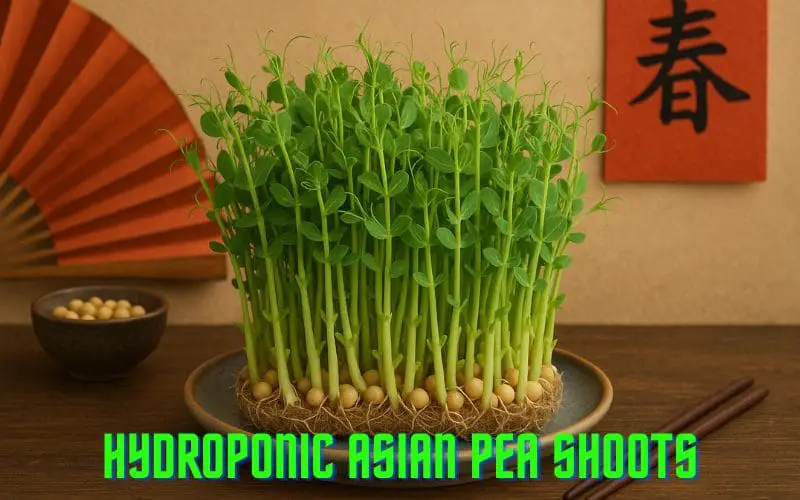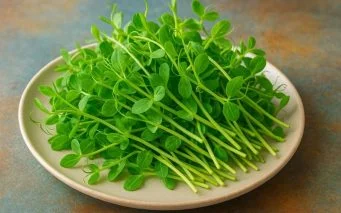Hydroponic Asian Pea Shoots: Fast & Easy Indoor Garden Guide

Introduction
Welcome to our comprehensive exploration of hydroponic soilless agriculture, where we will delve into the fascinating world of growing Asian pea shoots using innovative and sustainable techniques. Hydroponic Asian pea shoots, also known as microgreens, are flavorful and nutritious additions to any culinary creation. In this article, we will answer essential questions, explore the benefits of cultivating hydroponic Asian pea shoots, provide a step-by-step guide to growing them at home, examine their nutritional value, and discuss proper harvesting and storage methods. Join us as we embark on this enriching journey into the realm of hydroponic gardening and discover the wonders of these vibrant green delicacies.
Answer to the Question
Hydroponic Asian pea shoots are tender, young plants that are grown without soil in a controlled environment using water and essential nutrients. They are harvested at an early stage, typically when the first true leaves emerge, making them exceptionally flavorsome and nutritious. Through the innovative technique of hydroponic cultivation, these vibrant greens thrive in minimal spaces, providing a sustainable and convenient source of fresh produce.
Benefits of Hydroponic Asian Pea Shoots
Hydroponic Asian pea shoots are not only a flavorful and crunchy addition to meals—they’re also packed with nutritional benefits. These tender young leaves and tendrils of the pea plant are rich in vitamins, minerals, and antioxidants, and growing them hydroponically can even boost their purity and nutrient density by eliminating soil-borne contaminants and pesticides.
🌱 Nutritional Benefits of Hydroponic Asian Pea Shoots
-
High in Vitamin C – Boosts immunity and supports collagen production for skin and tissue repair.
-
Excellent Source of Vitamin A – Supports vision, skin health, and immune function.
-
Rich in Vitamin K – Essential for blood clotting and bone health.
-
Loaded with Antioxidants – Helps reduce inflammation and oxidative stress.
-
Good Source of Folate – Important for DNA synthesis and especially beneficial during pregnancy.
-
Low in Calories & Carbs – Ideal for weight management and low-glycemic diets.
-
Hydroponically Grown Advantage – Clean, pesticide-free, and often more nutrient-dense due to controlled growth conditions.
🧪 Nutritional Summary Chart
| Nutrient | Amount (per 100g) | Health Benefit |
|---|---|---|
| Vitamin C | ~45 mg | Immune support, skin health |
| Vitamin A (RAE) | ~385 µg | Vision, immune function |
| Vitamin K | ~25 µg | Blood clotting, bone health |
| Folate (Vitamin B9) | ~65 µg | Cell growth, pregnancy support |
| Fiber | ~3.5 g | Digestive health |
| Calories | ~35 kcal | Low-calorie, nutrient-rich |
| Antioxidants | High | Fights inflammation and cell damage |
Note: Values are approximate and can vary slightly based on growth conditions and harvest time.
How to Grow Hydroponic Asian Pea Shoots at Home
🌿 Materials Needed
| Item | Purpose |
|---|---|
| Pea seeds (Asian pea variety) | For growing (snow pea or sugar pea) |
| Shallow tray (without holes) | Holds water and acts as a growing base |
| Mesh tray or perforated lid | Sits on top to support seeds |
| Growing medium (optional) | Coconut coir, hemp mat, or paper towel |
| pH-balanced water (pH 6.0–6.5) | For soaking and irrigating |
| LED grow light or sunny window | Provides light for healthy growth |
| Spray bottle | For misting seeds and keeping them moist |
| Nutrient solution (optional) | A mild hydroponic nutrient blend |
| pH test kit or meter | Ensures optimal pH for growth |
🌱 Step-by-Step Instructions
1: Soak the Seeds
-
Rinse ½ to 1 cup of pea seeds thoroughly.
-
Place them in a bowl of water and soak for 8 to 12 hours (overnight).
-
This helps soften the seed coat and triggers germination.
2: Prepare the Tray
-
Place your growing medium in the shallow tray (if using). You can also grow without a medium by using just a mesh tray.
-
Add about ½ inch of clean water to the bottom tray. If using nutrients, mix them in now according to the label.
3: Add the Seeds
-
Spread the soaked seeds evenly over the top of the growing surface (medium or mesh tray).
-
The seeds can be touching but not piled on top of each other.
4: Cover and Keep Dark
-
Cover the tray with a lid, another tray, or a dark cloth for 2–3 days.
-
Keep it in a warm spot (65–75°F) to encourage sprouting.
-
Mist the seeds 1–2 times daily to keep them moist but not soaked.
5: Expose to Light
-
Once you see white roots and the seeds begin to sprout upward (day 3–4), remove the cover and move the tray under a grow light or bright window.
-
Keep the lights on for 12–16 hours/day if indoors.
6: Water Daily
-
Maintain about ½ inch of water in the bottom tray.
-
If using nutrients, refresh the water with a diluted nutrient mix every 2–3 days.
-
Make sure roots touch the water but are not fully submerged.
7: Harvest
-
Harvest when shoots are 4–6 inches tall, usually around 7–10 days after soaking.
-
Use clean scissors to snip just above the seed line.
-
Rinse, dry, and store in the fridge—or enjoy fresh!
🌟 Pro Tips:
-
Use food-safe trays and clean them before each batch.
-
Pea shoots are a one-cut crop—they won’t regrow well after harvesting.
-
If you want a second flush, leave some shoots uncut and allow another 4–5 days of growth.
Harvesting and Storing Hydroponic Asian Pea Shoots
✂️ How to Properly Harvest
🕒 When to Harvest:
-
Timing: 7–10 days after planting (or when shoots are 4–6 inches tall).
-
Visual cues: Look for bright green leaves with delicate tendrils and no yellowing or wilting.
🔪 Harvesting Steps:
-
Use clean, sharp scissors or kitchen shears.
-
Cut just above the seed line, about ½ inch from the base. This gives you the most tender part of the shoot.
-
Harvest all at once if you plan to eat or store them, or cut a few daily for fresh use.
-
Avoid pulling the roots—they’re not edible and can introduce moisture or spoilage during storage.
🧊 How to Store Pea Shoots for Freshness
🥬 Immediate Use:
-
After harvesting, gently rinse with cold water to remove any seed husks or debris.
-
Pat dry with a clean towel or use a salad spinner to remove excess moisture.
❄️ Short-Term Storage (Up to 7 Days):
-
Wrap shoots in a dry paper towel.
-
Place the wrapped shoots in a resealable container or zip-lock bag.
-
Store in the vegetable crisper drawer of your refrigerator.
-
Avoid airtight sealing if moisture is present—it can lead to mold.
🧺 Optional: Pre-Portion for Easy Use
-
Portion pea shoots into meal-size bundles before storing.
-
This reduces handling and helps maintain freshness.
⚠️ Tips to Prevent Spoilage:
-
Keep them dry: Moisture is the enemy of freshness. Always dry thoroughly before storage.
-
Check daily: Remove any wilted or slimy shoots.
-
Don’t freeze: Freezing damages the delicate leaves and ruins texture.
✅ Quick Summary Chart
| Step | What to Do |
|---|---|
| Harvest | Cut when 4–6″ tall, above the seed line |
| Rinse | Gently rinse and dry thoroughly |
| Storage | Wrap in dry towel, store in fridge |
| Shelf Life | 5–7 days if stored properly |
| Avoid | Excess moisture, freezing, cutting too low |
Conclusion
In conclusion, hydroponic Asian pea shoots offer an array of benefits that make them a valuable addition to any culinary venture. Their ease of cultivation, impressive nutritional content, and versatile culinary applications make them a sought-after commodity for home growers and professional chefs alike. By embracing the innovative practice of hydroponic cultivation, individuals can enjoy an abundant supply of these vibrant greens while contributing to sustainable and environmentally-responsible food production. So, whether you’re a gardening enthusiast, a health-conscious cook, or a culinary artist, consider adding hydroponic Asian pea shoots to your repertoire and savor the delightful flavors and nourishing qualities they bring to the table.

